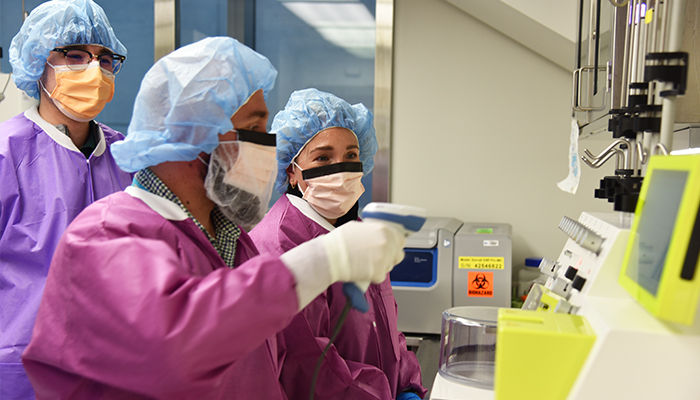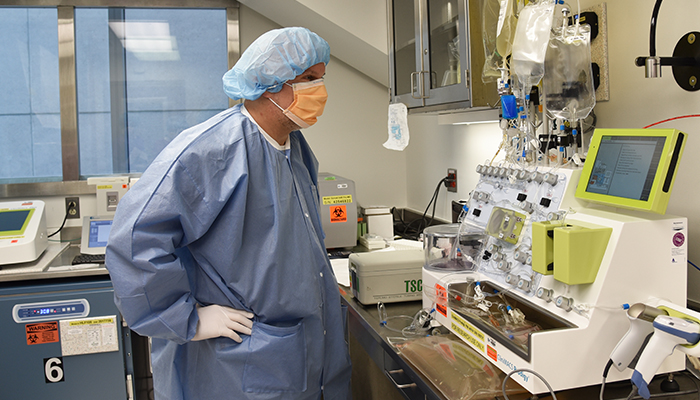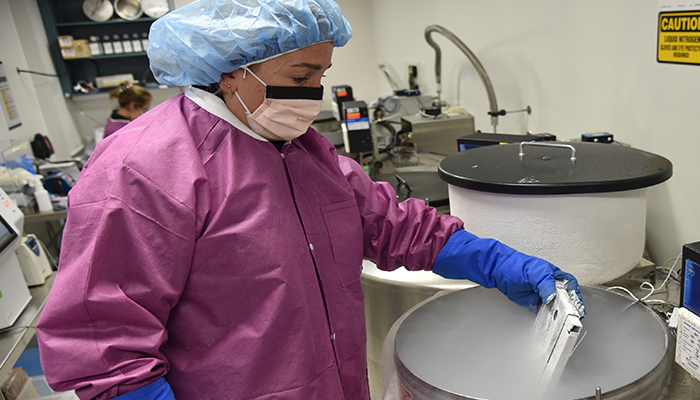HOW CAN WE HELP YOU? Call 1-800-TRY-CHOP
In This Section
At the Forefront of Breakthroughs: Cell and Gene Therapy Lab Sets Course for Expansion

Cell and Gene Therapy Lab team members, Rene Machietto, Nick Giacobbe, and Robert Rieser are pictured with the Prodigy system for CAR-T cell manufacturing. (Photo courtesy of Jason Roberts.)
Currently nestled in the Department of Pathology on the fifth floor of the Main Hospital at Children's Hospital of Philadelphia, the Cell and Gene Therapy Laboratory (CGTL) is poised to emerge in big way throughout 2024 and beyond as they expand their facilities to keep up with the pace of discovery in cell and gene therapy.
For the last thirteen years, the CGTL has worked behind the scenes to support high profile breakthroughs. Alongside their biggest customer, Stephan Grupp, MD, PhD, medical director of the Cellular Therapy and Transplant Section, the CGTL had a hand in manufacturing the first CAR-T cell therapy treatment in 2012 that has helped Emily Whitehead and many others lead cancer-free lives. Since then, the lab has become the sole provider for cell therapies at CHOP, active in more than 50 current clinical trials for experimental cell therapies. Most recently, the CGTL played a crucial role in the clinical trials that supported the approvals of two new gene therapies for sickle cell disease, handling the therapeutic products as they made their way to the patient.
"We've reached an inflection point in this field," said Lab Director Yongping Wang, MD, PhD. "All those years of research investments, along with academia and pharmaceutical industry advancements, have brought us to a critical juncture where there's suddenly a flood of these new products."
The lab, led by Dr. Wang and Associate Director Stephan Kadauke, MD, PhD, who also serves as medical director of Cell and Gene Therapy Informatics, processes and manufactures products for standard of care bone marrow transplantation and novel cell and gene therapies. It performs quality control tests on cells before moving them to one of their in-house cleanrooms – controlled environments that maintain sterile conditions – and releasing for patient infusion or shipment to an outside manufacturing site.
To do this, the lab must maintain current Good Manufacturing Practices (cGMP), which are a set of regulations enforced by the Food and Drug Administration (FDA) to ensure the quality and consistency of pharmaceutical products. Similar to pharmaceutical companies, they are also held to many of the same rules and are inspected by regulatory agencies, like the FDA and Foundation for the Accreditation of Cellular Therapy, to ensure these standards are met.

Stephan Kadauke, MD, PhD, is pictured in a “bunny suit,” also known as the personal protective equipment that is required to enter the cleanroom environment. (Photo courtesy of Jason Roberts.)
Regulations stipulate that one product can be active and processed in one cleanroom at a time. The CGTL currently has three cleanrooms at its disposal – which means at any given time, they can process no more than three products. With the gene therapy field evolving rapidly, the CHOP Board of Trustees has approved Dr. Wang and Dr. Kadauke to begin a phased expansion that will begin in 2024 with a projected completion date in three to four years.
Phase 1A is a short-term solution to address the sheer volume of processing requests the lab receives more efficiently. The lab will take over two more cleanrooms vacated by the Clinical Vector Core on the 12th floor of the Leonard and Madlyn Abramson Pediatric Research Center for a new total of five. Remodeling is almost complete, with a plan to be operational in the next two to three months.
A key addition that will go live in this first phase is a new Process Development Lab (PDL), a dedicated space where new investigational cell and gene therapies will be developed at clinical scale. By offering in-house process development, the CGTL hopes to streamline the path from bench to bedside while ensuring retention of intellectual property and keeping logistical control inside CHOP.
Although splitting their facility between two locations will take careful coordination, Dr. Wang and Dr. Kadauke are confident their diverse and detail-oriented team is well-equipped to manage it. Throughout the transition, they plan to continue to provide customer-focused service as they keep track of different therapeutic protocols for dozens of clinical trials, including one active, ongoing trial for which they are already manufacturing CAR T cells.

Lab supervisor, Rene Machietto, performs verification of cryo-preserved product from the CGTL’s liquid nitrogen tank. (Photo courtesy of Jason Roberts.)
"We have many capable people in our lab," Dr. Wang said. "These procedures are bespoke and custom, and we've been fortunate to work with highly specialized cell therapy specialists. We can only do the things that we do because of their dedication."
Phase 1B of the expansion plan will further increase the CGTL's processing capacity from five cleanrooms to seven. They must construct new facilities that adhere to cGMP standards with strict HVAC requirements, which typically require high ceilings only found on the bottom or top floors of buildings. This puts the lab's ultimate destination on the first floor of the Ruth and Tristan Colket Jr. Translational Research Building (CTRB). Four more cleanrooms will occupy what is currently office space on the ground floor.
Once those new spaces in CTRB are complete, they will vacate the cleanrooms in Abramson. Working with architects, Dr. Kadauke and Dr. Wang have designed certain spaces with glass panels, so onlookers can see the incredible work going on inside the cleanroom suites in CTRB.
In the future, the lab directors envision eight to 10 cleanrooms under one roof with an adjacent, expanded PDL. Ideally, product test runs will be performed in the PDL, and if successful, the product's transition to the cGMP cleanroom right next door will be swift and efficient, contributing to the end goal of treating more patients safely and cost-effectively at CHOP.
"What I'm most excited about is just the opportunity to make all these new therapies," Dr. Kadauke said. "We're expanding in terms of what we can do by such an order of magnitude that CHOP will be at the forefront of making these new products."
When the Cell and Gene Therapy lab, formerly the Stem Cell Laboratory, first opened its doors in 1986, it served as a clinical lab for bone marrow and stem cell transplantation until its first big move into a cGMP space on May 5, 2010. With their new manufacturing stamp of approval, the lab could begin to take on an increasing number of experimental cellular therapy protocols.
They officially changed their name to the Cell and Gene Therapy Laboratory in 2017 to reflect the breadth of their stem cell and non-stem cell related projects. The range of conditions they help treat continues to grow, including acute lymphoblastic leukemia, neuroblastoma, and sickle cell disease.
Cell and gene therapy researchers at CHOP interested in exploring opportunities for collaboration with the CTGL are invited to contact Dr. Kadauke and Dr. Wang for more information. The lab provides a supportive environment for navigating the complex landscape of investigational new drug-enabling research in cell and gene therapy, and the team looks forward to assisting researchers with their clinical transitions.